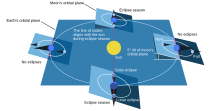Tio̍k-hiòng pêng-hêng-sèng

Tio̍k-hiòng pîng-hîng-sìng (ing-gú: axial parallelism; mā kiò-tsò kan-lo̍k kong-tōo (gyroscopic stiffness), kuàn-sìng (inertia) hi̍k-tsiá kong-sìng (rigidity), hi̍k-tsiá khong-kan kong-tōo (rigidity in space); tē-kiû tio̍k-hiòng pêng-hêng-tōo (earth axial parallelism, earth axial parallel degree), ti̍k-hiòng pîng-hîng-sìng) sī tńg-se̍h thé ê ti̍k-tsing; kî-tiong tng-tong bu̍t-thé teh khong-tiong suá-tāng ê sî-tsūn, tńg-se̍h tio̍k ê hong-hiòng pó-tshî kòo-tīng. Teh thian-bûn-ha̍k lāi-té, tsit-tsióng ti̍k-ting tsûn-tsāi teh kuí-tō siōng ê thian-thé tang-tiong. Tse kah tì-sú kan-lo̍k-gî ê tńg-se̍h tio̍k teh tē-kiû tńg-se̍h ê sî-tsūn pó-tshî hîng-tīng ê hāu-kó kāng-khuán, tsiū-án-ni hōo gî-khì ē-tàng tshik-liông tē-kiû ê tńg-se̍h.[1]
Huān-lē[siu-kái | kái goân-sí-bé]
Tē-tio̍k pîng-hîng-sìng[siu-kái | kái goân-sí-bé]

Tē-tio̍k uai-tshua̍h 23.5 tōo ê tē-kiû kuí-tō thîng-hiān kīn-sū tio̍k pîng-hîng, tsuân-nî pó-tshî uì-hiòng pak-ki̍k-tshenn ("pak-hiòng tshenn") ê hong-hiòng. Koh liân-tông tē-kiû ê tio̍k-hiòng uai-tshua̍h; tse tio̍h-sī tē-kiû sù-kuì piàn-huà ê tsú-iàu guân-in tsi it, pí-jû tsiànn-pîng ê tôo-lē sóo-sī.[2][3][4][5][6]
Teh 26,000 nî ê kuè-tîng tang-tiong, tio̍k ê hong-hiòng tio̍h huat-sing lî-lî-á ê piàn-huà, kiò-tsò tē-tio̍k tsìn-tōng. In-tsú, teh tsiap lo̍h-lâi ê 11,000 nî lāi-té, tē-tio̍k tio̍h-ē tsí-hiòng tsit-lú-tshenn jî m̄ sī pak-ki̍k-tshenn.[7]
Kî-thann thian-bûn sī-lē[siu-kái | kái goân-sí-bé]


Tio̍k pîng-hîng-sìng teh thian-bûn-ha̍k tang-tiong hông kóng-huàn kuan-tshat tio̍h. Pí-jû, gue̍h-kiû kuí-tō pîng-bīn ê tio̍k-hiòng pîng-hîng-sìng[8] sī si̍t hiān-siōng ê kuan-kiān in-sòo. Teh 18-nî 10-kang ê saros tsiu-kî tang-tiong, gue̍h-kiû ê kuí-tō tio̍k tsìn-tōng kui khoo-á. Tng-tong gue̍h-kiû kuí-tō khing-kak kah n̂g-tō khing-kak tuì-tsê ê sî-tsūn, tio̍h kah n̂g-tō khing-kak ū 29 tōo, m̄-koh teh in gi̍k-hiòng tuì-tsê ê sî-tsūn (9-nî āu), kuí-tō ê khing-kak kan-na sī 18 tōo. Tshú-guā, thóo-tshenn khuân teh hîng-tshenn se̍h thài-iông tńg-tsūn ê sî-tsūn pó-tshî kòo-tīng ê hong-hiòng.[9]
Tsù-kái[siu-kái | kái goân-sí-bé]
- ↑ Kumar, B.; DeRemer, D.; Marshall, D. (2005). An Illustrated Dictionary of Aviation. McGraw-Hill Education. p. 326. ISBN 978-0-07-139606-6. 2022-12-03 khòaⁿ--ê.
Because of rigidity in space, a gyroscope does not tilt its axis of rotation as the earth rotates.
(Eng-gí) - ↑ Petersen, J.; Sack, D.; Gabler, R.E. (2014). Fundamentals of Physical Geography. Cengage Learning. p. 18. ISBN 978-1-285-96971-8. 2022-12-02 khòaⁿ--ê. (Eng-gí)
- ↑ The Popular Educator. John Cassell. 1856. p. 89. 2022-12-02 khòaⁿ--ê. (Eng-gí)
- ↑ Oliver, J.E. (2008). Encyclopedia of World Climatology. Encyclopedia of World Climatology. Springer Netherlands. p. 651. ISBN 978-1-4020-3264-6. 2022-12-02 khòaⁿ--ê. (Eng-gí)
- ↑ Rohli, R.V.; Vega, A.J. (2011). Climatology. Jones & Bartlett Learning, LLC. p. 30. ISBN 978-1-4496-5591-4. 2022-12-02 khòaⁿ--ê. (Eng-gí)
- ↑ Lerner, K. Lee; Lerner, Brenda Wilmoth (2003). World of earth science. Farmington Hills, MI: Thomson-Gale. p. 487. ISBN 0-7876-9332-4. OCLC 60695883.
Although these distances seem counterintuitive to residents of the Northern Hemisphere who experience summer in July and winter in January—the seasons are not nearly as greatly affected by distance as they are by changes in solar illumination caused by the fact that Earth's polar axis is inclined 23.5 degrees from the perpendicular to the ecliptic (the plane of the solar system through or near which most of the planet’s orbits travel) and because the Earth exhibits parallelism (currently toward Polaris, the North Star) as it revolves about the Sun.
(Eng-gí) - ↑ Lerner, K. Lee; Lerner, Brenda Wilmoth (2003). World of earth science. Farmington Hills, MI: Thomson-Gale. p. 105 and 454. ISBN 0-7876-9332-4. OCLC 60695883.
During revolution about the Sun, the earth's polar axis exhibits parallelism to Polaris (also known as the North Star). Although observing parallelism, the orientation of Earth’s polar axis exhibits precession—a circular wobbling exhibited by gyroscopes—that results in a 28,000-year-long precessional cycle. Currently, Earth’s polar axis points roughly in the direction of Polaris (the North Star). As a result of precession, over the next 11,000 years, Earth's axis will precess or wobble so that it assumes an orientation toward the star Vega.
(Eng-gí) - ↑ Gravesande, W.J.; Desaguliers, J.T.; Newton, I. (1726). Mathematical Elements of Natural Philosophy Confirmed by Experiments, Or An Introduction to Sir Isaac Newton's Philosophy ... Translated Into English by J. T. Desaguliers ... The Second Edition, Carefully Review'd and Corrected by the Translator. p. 184. 2022-12-03 khòaⁿ--ê.
The Axis of the Moon is not perpendicular to the Plane of its Orbit, but a little inclin'd to it: The Axis keeps its Parallelism in its Motion round the Earth
(Eng-gí) - ↑ Ferguson, J. (1673). Astronomy Explained Upon Sir Isaac Newton's Principles ... A New Edition, Corrected. [With Plates.]. W. Strahan. p. 189. 2022-12-02 khòaⁿ--ê. (Eng-gí)
Tsham-ua̍t[siu-kái | kái goân-sí-bé]
- Axial tilt
- Polar motion
- Rotation around a fixed axis
- True polar wander
- Solar eclipse
- Lunar eclipse
Guā-pōo liân-kiat[siu-kái | kái goân-sí-bé]
 YouTube téng ê Axial Parallelism ê iáⁿ-phìⁿ (Eng-gí)
YouTube téng ê Axial Parallelism ê iáⁿ-phìⁿ (Eng-gí) YouTube téng ê The Earths Tilt ê iáⁿ-phìⁿ (Eng-gí)
YouTube téng ê The Earths Tilt ê iáⁿ-phìⁿ (Eng-gí)- Causes of Seasons Earth's Tilt Parallelism of Earth's Axis (Eng-gí)
